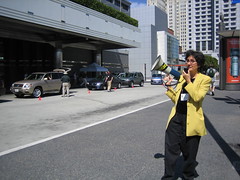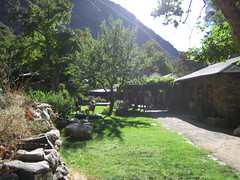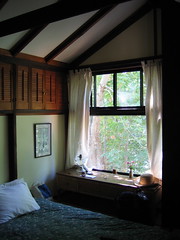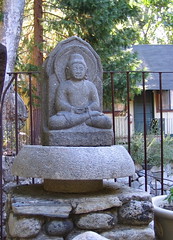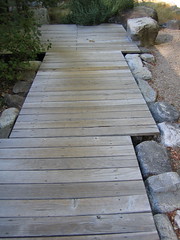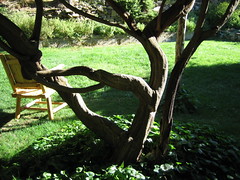The New Orleans footage having catapulted domestic news to a new level of grim reality, it seems frivolous to discuss anything else. We are now having to watch our own piece of the Third World unravel right before our primetime eyes and ask the appropriate questions about our infrastructure and our government. I will not add to the fray. Instead I offer my report of a place of peace tucked into the mountains of Carmel, our own Shangri-La.As a vacation spot the appeal of Tassajara is subtle. Nice, I thought when we first visited four years ago, but not compelling enough to return again and again. I'm one for novelty and seeking out new vistas. It's Catherine who yearns for Tassajara, she, who is tempted to leave everything and take up the monastic life. You can do that there. It is a year round residence for Zen practitioners. Part of the
Zen Center in San Francisco.
Catherine loves the bells calling the practitioners to the temple. The tock, tock, tock of a wooden mallet on wood block, then the big bell rung. There is a ritual to it. Zen practitioners are fond of ritual and discipline. (We Vispassana students are not so strict.) They are roused at 5 a.m. at this monastery. Someone runs by ringing a hand bell. You can hear the beat, beat, beat of footsteps passing by.
In the summer months the monastery turns into a spa resort and interns come to help in exchange for room and board. (You cannot book with a credit card though. Something about not supporting debt in order for peolple to come here.) Classes and workshops are offered. Our meditation teacher,
Gil Fronsdal, gives one every year. It is to attend his workshop that we come. Usually a five-day meditation retreat, this year's topic is on the Buddhist practice of loving kindness.
Tucked into the Los Padres National Forest in the Carmel Valley, Tassajara is easy to get to until the last hour down the side of the mountain on a rutted dirt road. Secluded in this canyon there is no leaving to pop over to the mall if you forgot something. We park our car at the road's end and pull our bags on carts the last 500 yards or so into the monastery.
We know the routine. It is our fourth stay and we make our way to one of the familiar little one room cabins that served tourists in the 1890's when this was a getaway for city folk who came down the mountain in a horse drawn wagon, dragging a log to keep from tumbling down.
It was in the 60's that Suzuki Roshi, founder of the Zen Center, discovered Tassajara and realized it would be perfect for what he had in mind, a rural place of practice secluded from the outside world.
Ours is the last cabin, near the pool. It is one of the Japanese style cabins and has a lovely view of the river. The bed is on the floor on tatami mats. There is a toilet (super low flush) and sink in the adjoining bathroom. (Showers are at the communal bathhouse.) No electricity, just oil lamps. Only the communal buildings, the dining room, kitchen, workshop and meditation hall have electricity. Diesel powered generators and solar panels supply this off-the-grid village. Later we buy raffle tickets to help them raise money for more solar panels.
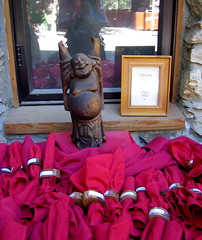
We are just in time for lunch. Outside the dining hall we look among the pile of red napkins for one labelled with our names. This would be our napkin for the week. It goes with the red tablecloths, All meals are vegetarian of such gourmet quality that eating is a major part of the Tassajara experience. Sitting down to onion soup and that famous bread, we meet other workshop participants. There will be 15 in all; several from our Sangha (meditation community) so already there are familiar faces.
Our meetings are at the other end of the camp in a large yurt where a circle of black mats and cushions are already laid out waiting for us. We sit together for the first time that evening, then meet again before breakfast. Already my mind is relaxed, distanced from the complex information I spend my time processing.
"This is too easy," I thought at our first morning meditation. My two most annoying irritants of everyday life - the car culture and the news media have been removed. How would I apply myself? I spent the first day listening to the other participants and saying little.
When I first came to Buddhist meditation practice with Americans, I expected people to be as laid back and easy going as the Thais I grew up with. I don't know why I thought the practice would instantly transform Americans from the bossy, controlling, opinionated people already populating my life. And here they were trying so hard to overcome these traits. I realized I was learning more about Americans than I was about Buddhism.
American Buddhism is vital, drawing new people all the time. From the point of view of native Buddhists this was changing Buddhism culturally, but it could be the "lion's roar". The voice that takes the teachings forward. And how powerful this voice would be, I thought, given the innate teachings of democracy and social justice and the personal sense that individuals could actually make change here in America. Give this righteousness a grounded practice that offered equanimity and calm rather than anger and fear and I could see the voice persist for as long as it was needed. For myself I was still working on becoming righteous and acquiring the sense that I could have an impact on others, be influential.
The first book I read about meditation called
Mindfulness in Plain English was not written by a Westerner. My aunt in Thailand gave it to us. It was indeed the clearest instruction of what we were to attempt to do through meditation. We started immediately at a serene resort on Koh Samui in our room by the sea. I chose for myself a mantra.
"One potato, two potato," I counted. I was so self-amused by this choice, it took my whole concentration not to burst out laughing. The pure entertainment value of the act kept me interested.
Back at home we sat every day, each on our own. As I studied my thoughts I was struck by the energy of a repeating dialogue. This conversation turned out to be devoted to defending myself from the assumptions of Western psychology, my mother's field. Well what a waste of time, I realized and gave it up. Thus freed from the internalized torture of Western thought I finished out the year of meditation and let my practice go except for the Sunday session at our insight meditation center. (Now I sit with Catherine as a way to start the day together.)
As I listened to my fellow workshop participants describing what was going on in their heads, I was reminded again of how hard Westerners are on themselves. The feelings of guilt and unworthiness and then beating themselves up for not meditating well enough. My heart went out to them while at the same time I wondered what I was doing. If left to my own devices I would spend my entire practice time writing in my head and telling jokes to myself.
I followed Gils guided meditations. He took us through the steps of the loving kindness practice. The practice starts with thinking the phrases for oneself. May I be happy, may I be safe, may I be healthy, may I be at ease.
This feels good I thought. I have no enemies. Next we did the same blessing to a benefactor. I felt very present finally. It was day three.
We had lots of free time to hike and read. It was hot, so best to stay cool draped in wet garments. In the evening we sat in the bathhouse, soaking in the hot springs, gazing at the night sky. So many stars there were. The sky had texture, depth and satellites drifting across it. The Milky Way so distinct like a field of scattered snow crystals. We shared details of our lives with each other. One of us mentioned that Tassajara had one imperfection - not enough lounge chairs. "Makes my slothfulness impermanent," I quipped. Everyone laughed. A Buddhist joke.
In the context of our loving kindness workshop was an elephant in the room. Soon we would be asked to address our enemies our difficult person. Gil would not be discussing the problem of the elephant; but we talked about it among ourselves. Who could stomach giving the loving kindness blessing to Bush and co.? One of us would take on the challenge, but not me.
Gil had said that this practice was not so much for the recipient of our blessings, but for ourselves and our well being in the world. Wishing Bush and company well would be meaningless to me. I didn't know them as people in my life. When they disturbed my equanimity I worked towards accepting the harm they were doing and set about educating others about the harm. I did not believe that sending them love would help. It reminded me too much of the days of the harmonic convergence and new agers hoping to change the world by exuding love to all those intent on robbing and pillaging. Was this not magical thinking? They are still robbing and pillaging. Eventually we must remove the wolf from the lambs.
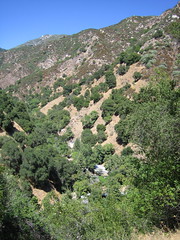
It was not until day five that I began to see some point in the exercise. That was the day of expanding the practice to all beings everywhere. Gil had us extend our goodwill to the entire village of Tassajara, then out to Carmel valley, then out to the entire state of California. That meant people with guns and pick-up trucks in the outback and all, I realized. Could I extend the blessing to SUV drivers? Okay, maybe they wouldn't drive so much if they were happy. They would stay put and if they felt safe they wouldn't be out buying duct tape. In fact the world would be a better place if everyone just felt at ease. My goodwill extended up and out into the deep blueness of the sky, flowed over the mountains and hovered above the earth.
This was the beauty of Tassajara. It got under your skin. People were at ease here. They felt safe. There were no locks on the cabin doors, just a hook. There was no competition, no fashion imperatives unless you count the black Zen robes some of the monks wore which were pretty stylin'. But most just wore layers of loose comfortable wrappings.
And even though guests might stay only a few nights, there was continuity to their presence, a mindfulness of each other. This gentleness gave a sense of timelessness to the life here as if each visitor was just carrying on in the footsteps of another along with those who worked there.
With no CNN, no TV at all, one public phone and the occasional newspaper usually three days old, Tassajara was truly remote from the world down at the bottom of that canyon.
"Peace could break out and we wouldn't even know it," a guest commented wryly.
It was also a community in harmony with the earth. Signs were posted to conserve water, use biodegradable products, compost, re-use your lunch bag. Food was grown and flowers. This was living lightly on the earth. What more did we really needed as a people? Tassajara was showing us how we could live sustainably and be happier too.
Labels: Buddhism, meditation, monastery, Tassajara
